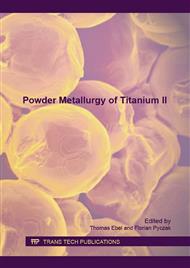[1]
K. Otsuka, T. Kakeshita, Science and technology of shape-memory alloys: New developments, MRS Bulletin (2002) 91-100.
DOI: 10.1557/mrs2002.43
Google Scholar
[2]
K. Otsuka, X. Ren, Physical metallurgy of Ti-Ni-based shape memory alloys, Progress in Materials Science 50 (2005) 511-678.
DOI: 10.1016/j.pmatsci.2004.10.001
Google Scholar
[3]
A. Smolders, D. Aslanidis, A. Serneels, S. Van den Bossche, W. Vandermeulen, Manufacturing of shape memory alloys by powder metallurgy, Proc. of the First European Conf. on Shape Memory and Superelastic Technologies (SMST-99), Antwerp, Belgium (1999).
Google Scholar
[4]
M. Bram, A. Ahmad-Khanlou, A. Heckmann, B. Fuchs, H.P. Buchkremer, D. Stöver. Powder Metallurgical fabrication processes for NiTi shape memory alloy parts, Materials Science and Engineering A337 (2002) 254-263.
DOI: 10.1016/s0921-5093(02)00028-x
Google Scholar
[5]
Ph. Imgrund, A. Rota, H. Schmidt. μ-MIM: Making the most of NiTi, in Metal Powder Report, May 2008, 21-24.
DOI: 10.1016/s0026-0657(08)70057-2
Google Scholar
[6]
J. -E. Bidaux, A. Jochem, E. Carreño-Morelli, Powder injection moulding of NiTi shape memory alloys, Powder Injection Moulding International, vol. 2 N°1 (2008) 59-62.
DOI: 10.1179/0032589913z.000000000118
Google Scholar
[7]
M. H. Ismail, R Goodall, H. A. Davies, I. Todd, Porous NiTi metal injection moulding/sintering of elemental powders: Effect of sintering temperature, Materials Letters 70 (2012) 142-145.
DOI: 10.1016/j.matlet.2011.12.008
Google Scholar
[8]
G. Chen, P. Cao, G. Wen, N. Edmonds, Y. Li, Using an agar-based binder to produce porous NiTi alloys by metal injection moulding, Intermetallics 37 (2013) 92-99.
DOI: 10.1016/j.intermet.2013.02.006
Google Scholar
[9]
L. Krone, E. Schüller, M. Bram, O. Hamed, H.P. Buchkremer, D. Stöver. Mechanical Behaviour of NiTi parts prepared by powder metallurgical methods, Materials Science and Engineering, Vol A378 (2004) 185-190.
DOI: 10.1016/j.msea.2003.10.345
Google Scholar
[10]
L. Krone, J. Mentz, M. Bram, H. P. Buchkremer, D. Stöver, M. Wagner, G. Eggeler, D. Christ, S. Reese, D. Bogdanski, M. Köller, S. A. Esenwein, G. Muhr, O. Prymak, M. Epple. The potential of powder metallurgy for the fabrication of biomaterials on the basis of nickel-titanium: A case study with a staple showing shape memory behaviour, Advanced Engineering Materials, Vol 7, No 7, (2005).
DOI: 10.1002/adem.200500029
Google Scholar
[11]
M. Bram, M. Bitzer, H.P. Buchkremer, D. Stöver. Reproducibility study of NiTi parts made by Metal Injection Molding, Journal of Materials Engineering and Performance (2012) DOI: 10. 1007/s11665-012-0264-6.
DOI: 10.1007/s11665-012-0264-6
Google Scholar
[12]
E. Schüller, L. Krone, M. Bram, H. P. Buchkremer, D. Stöver, Journal of Materials Science, 40 (2005) pp.4231-4238.
Google Scholar
[13]
J. Mentz, M. Bram, H.P. Buchkremer, D. Stoever, Improvement of mechanical properties of powder metallurgical NiTi reduction of impurity phases, Proc. of the International Conference on Shape memory and superelastic technologies, Pacific Grove, USA (2006).
DOI: 10.1002/adem.200500258
Google Scholar
[14]
T. Saburi, Ti-Ni shape memory alloys, in Shape memory materials, Eds. K. Otsuka, C. M. Wayman, Cambridge University Press, Cambridge, 1998, 49-96.
Google Scholar
[15]
Y. Shugo, S. Hanada, T. Honma, Effect of oxygen content on the martensite transformation and determination of defect structure in TiNi alloys, Bull. Res. Inst. Miner. Dress. Metall., 41 (1985) 23-34.
Google Scholar
[16]
R. Pelton, J. DiCello, S. Miyazaki, Optimisation of processing and properties of medical grade Nitinol wire, Min. Invas. Ther. & Allied Technol., 9 (1) (2000) 107-118.
DOI: 10.3109/13645700009063057
Google Scholar
[17]
K. Otsuka, Introduction to the R-phase transition, in Engineering aspects of shape-memory alloys, T. W. Duerig, K. N. Melton, D. Stöckel, C. M. Wayman (Eds. ), Butterworth-Heinemann Ltd, London, 1990, 36-45.
DOI: 10.1016/b978-0-7506-1009-4.50007-x
Google Scholar
[18]
T. Goryczka, M. Morawiec, Structure studies of the R-phase using X-ray diffraction methods, Journal of Alloys and Compounds, 367 (2004) 137-141.
DOI: 10.1016/j.jallcom.2003.08.025
Google Scholar
[19]
H. Hosoda, T. Inamura, Mechanical properties of shape memory alloys, in Shape memory alloys for biomedical applications, Eds. T. Yoneyma, S. Miyazaki, Woodhead Publishing Limited, Cambridge, 2009, 20-36.
DOI: 10.1533/9781845695248.1.20
Google Scholar


